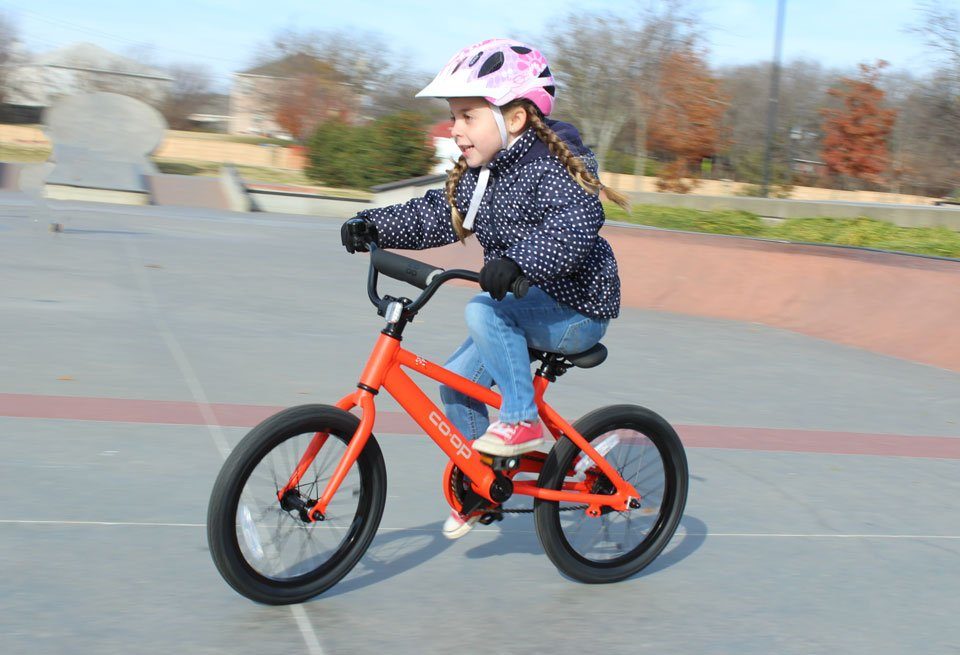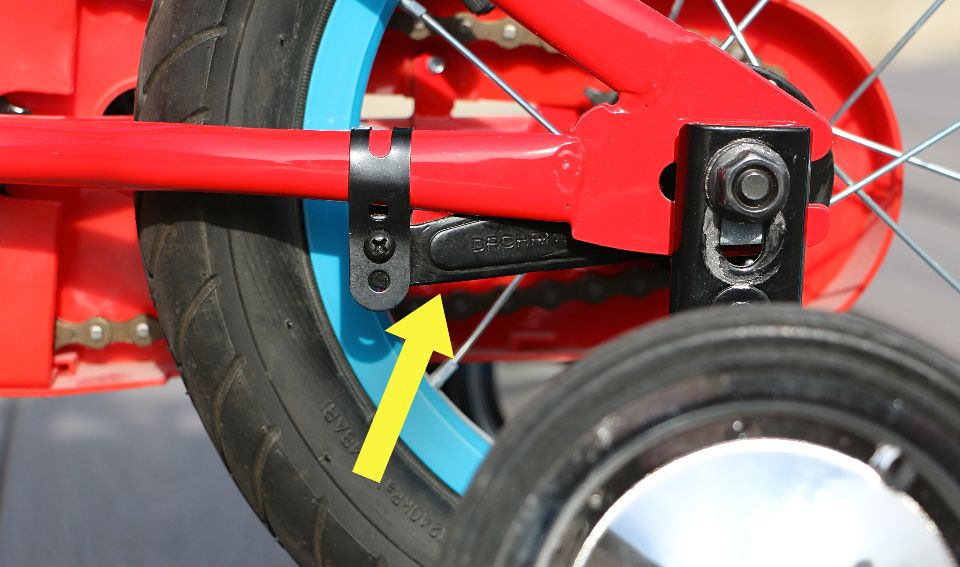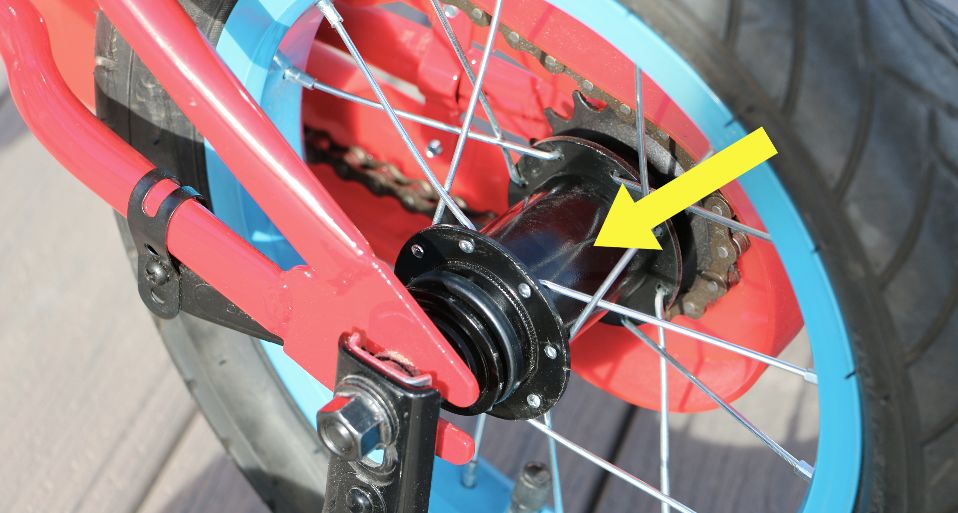Coaster brakes, also known as back-pedal brakes or foot brakes, are the standard brake system found on most kids bikes. They are simple in design and require essentially zero maintenance, which makes them appealing to many bike owners. Just pedal backwards and engage the brake. Easy, right?
Coaster brakes may be easy to engage and easy to maintain, but they also have their problems. In fact, after testing out over 100 different kids’ bikes over the last 13 years, we strongly recommend that parents try to avoid bikes with coaster brakes.

TABLE OF CONTENTS
- What is a coaster brake?
- Why are coaster brakes a problem on kids bikes?
- Which kids bikes do not have coaster brakes?
- Why do some bikes have coaster brakes and others have hand brakes?
- How do you remove a coaster brake on a bike?
- How does a coaster brake work?
- How do you install a freewheel kit?
- Are coaster brakes problematic on adult bikes?
What is a coaster brake?
A coaster brake on a bike is a braking system that is set in motion by pedaling backward. As a result, coaster brakes are also known as backpedal brakes. They are commonly found on kids bikes as well as adult cruiser-style bicycles, but are never found on technical bikes such as mountain bikes or road bikes.
Bikes with coaster brakes are quite easy to spot due to the brake arm that is attached to the chainstay of the bike (typically on the left side of the bike – the opposite side to where the chain is mounted). Whether you are looking at a bike online or in a shop, spotting the brake arm is a fool-proof way to determine whether a bike has a coaster brake.

Some high-end adult bikes with internally geared hubs (such as Priority Classic), have a coaster brake but do not have a brake arm attached to the chainstay of the bike. This is rare and as far as we know, these expensive high-end hubs are not used on kids bikes.
Why are coaster brakes a problem on kids bikes?
There are four main reasons why coaster brakes are problematic on kids bikes.
- Less efficient braking compared to hand brakes
- The inability to pedal backwards to regain balance
- Difficulty in placing pedals in the “start” position
- Loss of all braking abilities upon chain falling off
Less Efficient Braking – Coaster Brake vs Hand Brakes
Quality hand brakes on a bike require much less effort to engage and provide much more stopping power compared to coaster brakes. Advancements in bicycle components in the last decade have greatly increased the efficiency of hand brakes, allowing bikes to stop faster and with much less effort by the rider.
Many parents will recall the great efforts required to activate handbrakes on their bikes as kids. Nowadays, a properly adjusted, high-quality hand brake can easily be activated by using just your pinky finger (try it!). If the hand brake is hard to pull with your pinky, it either needs a tune-up or is poorly designed.
That being said, it is true that many kids bikes currently have terrible hand brakes that simply don’t work! These poor quality brakes are typically only found on cheaper, big-box store bikes. These bikes almost always come with a coaster brake as well, so if you do have a budget bike with a handbrake, it’s best to teach your child to rely on the coaster brake.
The Benefits of Pedaling Backward!
Coaster brakes can be detrimental to a rider because they eliminate the ability to ever pedal backward. Why does this matter? While pedaling backward clearly doesn’t propel a bike forward, there are two main reasons why being able to do so is beneficial to a young rider.

Makes Learning to Pedal Easier
First, pedaling backward is a natural part of learning how to pedal a bike. When young kids are learning how to pedal, they often mistakenly pedal backward instead of forward. When this occurs on a bike with a coaster brake, the bike quickly comes to an unexpected stop, which usually leads to a fall.
On a bike without a coaster brake, kids can accidentally pedal backward without any negative affects. They can pedal backward, realize their mistake, and then pedal forward again without skipping a beat.
Helps to Regain Balance
Second, pedaling backward can help you regain your balance. As adults, we’ve all been there and have had to pedal backward in order to regain our balance on a bike. Kids are the same way!
Whether they are just learning how to balance a bike or are struggling to maintain their balance while going slow or riding up a hill, kids have the natural instinct to pedal backward in order to help regain their balance. If a bike has a coaster brake, they lose this ability.
Setting Pedals to the Start Position
The difficulty of setting pedals in the “start” position is another downside to coaster brakes. The “start” position is when one of the pedals is in its highest position with the crank arm essentially perpendicular to the ground.

The “start” position is benefical as it allows the bike to gain the most speed and momentum from the get-go. For kids, this initial burst of speed is important because bikes are much more stable and easier to ride at higher speeds.
If a bike has a coaster brake, moving the pedal to the start position can be very challenging. Without the ability to move the pedals backward (they stop as a result of the coaster brake), the rear tire of the bike must be lifted off the ground in order to move the pedals forward. This skill is much too difficult for young riders to master.
On a bike without a coaster brake, kids quickly and easily learn to move the pedals backward in order to get the pedals in start position.
Potential for Brake Failure
One thing to keep in mind about a coaster brake (on any bike) is that it will not work if the chain of a bike comes off or gets jammed. Coaster brake hubs can only engage the brake if the rider is able to pedal the bike backward while there is tension on the chain. The tension of the chain is required to activate the braking mechanism inside the hub.
The loss of braking due to the chain coming off will be sudden and complete. Your child will have no way to stop the bike aside from dragging their feet on the ground.
Which kids bikes do not have coaster brakes?
Check out our kids bike comparison charts to quickly see which bikes have coaster brakes and which do not. These charts, broken down by size, also include the weight, seat heights, and MSRP of each bike to help you easily narrow down your options.
NOTE: For the 12″ and 14″ bikes, a YES in the column “Freewheel Option” indicates the coaster brake can be removed.
- 12″ and 14″ Bikes Comparison Chart
- 16″ Bikes Comparison Chart
- 20″ Bikes Comparison Chart
- 24″ Bikes Comparison Chart
Aren’t sure which size bike your child needs? Our kids bike sizing guide will help you quickly and accurately determine the best size bike for your child.
Why do some bikes have coaster brakes and others have hand brakes?
Due to CPSC requirements, most 12″, 14″, and even some 16″ kids bikes are required to have coaster brakes. When the regulation was crafted back in the ’70s, handbrakes on bikes were very difficult to use, so coaster brakes were considered to be the safest for kids.
Sadly, 50 years later the CPSC regulation has yet to be updated. So even though coaster brakes are now less efficient than quality hand brakes, they are still required on the smallest of bikes.
There is, however, a lot of gray area as to how the CPSC regulation is applied. As a result, some smaller kids bikes are available without coaster brakes, but not many.
As mentioned above, we certainly recognize that cheap hand brakes do not perform as well as coaster brakes. Our hope is that the US standard will eventually be updated to be similar to the European standard. Not only does the European standard not require coaster brakes, it also bans cheap hand brakes that are very inefficient and never stay in tune.
How do you remove a coaster brake on a bike?
Since coaster brakes are incorporated into the hub of a bike, you can’t simply turn them off. In order to remove one from a bike, you must either replace or modify the bike’s rear hub.
If you happen to have a woom 2, Prevelo Alpha One, or a Pello Romper, however, “freewheel kits” are available to allow you to easily remove the coaster brake (see more in the next question).
Replacing the bike’s hub is quite complicated and isn’t a DIY task! But for the really adventurous spirits, the guys over at Stacked BMX came up with a way to modify a coaster brake hub to remove the brake. We haven’t tried this ourselves, but for those who are really aching to get the coaster brake removed, this might be worth a shot.
If you attempt to modify your coaster hub, be sure to first ensure that your bike has at least a well-tuned and fully-functional rear hand brake. Ideally, the coaster brake should not be removed unless the bike has front and rear hand brakes.
DO NOT remove the coaster brake on a bike that only has a front hand brake! Braking with just the front wheel is unsafe and can cause the rear tire to pop up and buck off a child when the brake is engaged.
How does a coaster brake work?
The magic of coaster brakes is in the rear hub. The hub of a bike is the center component of the wheel to which the spokes attach. The rear axle of a bike travels through the the rear hub.

Essentially all of the components needed to stop the bike are located inside a coaster brake hub. With no moving outside parts to get banged around, the main appeal of coaster brakes is that they are essentially maintenance-free.
Upon pedaling backward, the coaster brake hub stops a bike by pushing a brake shoe against the inside edge of the rotating hub. With the brake engaged, the rear hub can’t rotate, which then stops the rear wheel of the bike. To see this in action, RJ The Bike Guy has a great 7-minute video that clearly shows the mechanics of a coaster brake.

How do you install a freewheel kit?
In order to offer young riders a riding experience without coaster brakes, many high-end brands (including woom, Prevelo and Pello) offer freewheel kits for their 14″ bikes. Freewheel kits consist of an entirely new rear wheel that the consumer swaps out for the bike’s standard wheel. This freewheel features a freewheel hub instead of a coaster brake hub.
Due to differences in bike frames and components, freewheel kits are not interchangeable between brands. So unless your bike’s manufacturer offers a freewheel kit for your specific model, installing a freewheel kit will not be an option for you.
Because the CPSC regulation does not prevent a consumer from modifying a bike once they have purchased it, companies can legally sell freewheel kits. However, they must ship the bike with the coaster brake wheel installed.
Swapping out a coaster rear wheel for the freewheel kit is quick and easy, and pretty standard across all brands. This 4-minute video from Prevelo demonstrates step-by-step procedures on how to make the swap.
Are coaster brakes problematic on adult bikes?
Coaster bikes are not exclusive to kids bikes and can also be found on adult neighborhood bikes such as cruiser bikes. For use around town, especially in flat areas, coaster brakes typically perform just fine for adults.
Due to their ability to heat up quickly, coaster brakes are not recommended for any type of technical riding, riding at fast speeds, or around hills.

Based on our own experience, they aren’t ideal when pulling kids in a trailer or when using a baby bike seat, but not a deal-breaker. If your bike happens to have coaster brakes, just make sure to ride at a much slower pace than usual when using a trailer or a bike seat.
Since coaster brakes really don’t allow you to come to a slow and controlled stop like hand brakes, stopping often comes as a quick jolt. With the extra weight of a child seat or a trailer, this jolt can be more pronounced and quite unexpected for the adult rider. In extreme cases, this jolt can cause the rider to lose their balance and potentially fall over. As a result, be sure to stick to slower speeds and avoid hilly areas!
